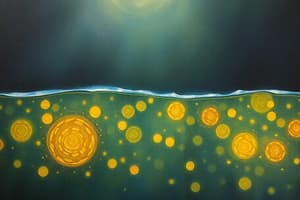Podcast
Questions and Answers
What is the primary structure provided by the lipid bilayer?
What is the primary structure provided by the lipid bilayer?
Basic structure for all cell membranes
What types of molecules constitute about 50% of the mass of most animal cell membranes?
What types of molecules constitute about 50% of the mass of most animal cell membranes?
- Carbohydrates
- Nucleic acids
- Proteins
- Lipids (correct)
Amphiphilic molecules have both hydrophilic and hydrophobic properties.
Amphiphilic molecules have both hydrophilic and hydrophobic properties.
True (A)
What do hydrophilic molecules readily dissolve in?
What do hydrophilic molecules readily dissolve in?
What causes phospholipid molecules to form bilayers spontaneously in aqueous environments?
What causes phospholipid molecules to form bilayers spontaneously in aqueous environments?
What happens to the hydrophobic hydrocarbon tails when a phospholipid bilayer closes?
What happens to the hydrophobic hydrocarbon tails when a phospholipid bilayer closes?
Match the following lipid types with their description:
Match the following lipid types with their description:
Flashcards are hidden until you start studying
Study Notes
Cell Membranes: Overview
- Cell membranes are essential for life.
- They enclose the cell, define its boundaries, and maintain differences between the cytosol and the extracellular environment.
- They contain proteins that act as sensors of extracellular signals, enabling the cell to respond to environmental changes and signals from other cells.
- All biological membranes share a common structure despite having different functions.
The Lipid Bilayer: Structure and Function
- The lipid bilayer provides the basic structure for all cell membranes.
- Lipids make up approximately 50% of the mass of most animal cell membranes, with proteins comprising the majority of the remaining mass.
- The bilayer structure is easily visible using electron microscopy.
- This structure is due to the special properties of lipid molecules, which spontaneously assemble into bilayers even under simple artificial conditions.
Amphiphilic Lipids: The Key to Bilayer Formation
- All lipid molecules in cell membranes are amphiphilic, possessing both hydrophilic (water-loving) and hydrophobic (water-fearing) ends.
- The hydrophilic ends typically contain charged groups or polar groups, facilitating interactions with water molecules through electrostatic interactions or hydrogen bonding.
- The hydrophobic ends are composed of uncharged and nonpolar atoms, preventing them from forming energetically favorable interactions with water molecules.
Spontaneous Bilayer Formation: A Balancing Act
- The amphiphilic nature and shape of phospholipid molecules cause them to spontaneously form bilayers in aqueous environments.
- The shape of these molecules dictates whether they form micelles or bilayers. Cone-shaped molecules form micelles, while cylinder-shaped molecules form bilayers.
- Bilayer formation is driven by the tendency to minimize exposure of hydrophobic tails to water, maximizing stability by creating a sealed compartment.
Major Lipids in Cell Membranes: Building Blocks of Life
- Phosphoglycerides, sphingolipids, and sterols are the major lipid components of cell membranes.
- Phosphoglycerides are the most abundant membrane lipids, featuring a three-carbon glycerol backbone, two long-chain fatty acids, and a phosphate group.
- The phosphate group is connected to a polar head group, adding to the amphiphilic nature of the molecule.
- The fatty acid tails can be saturated or unsaturated, influencing the fluidity of the membrane.
Studying That Suits You
Use AI to generate personalized quizzes and flashcards to suit your learning preferences.




